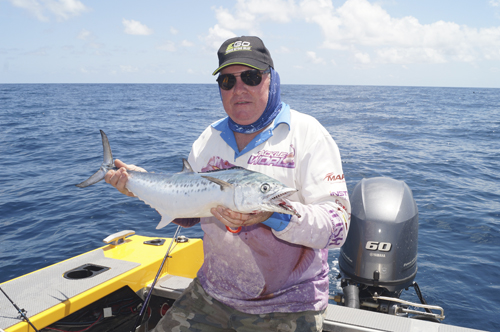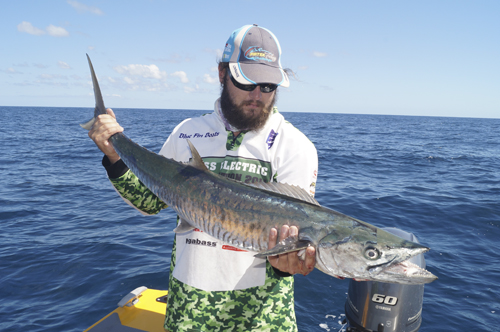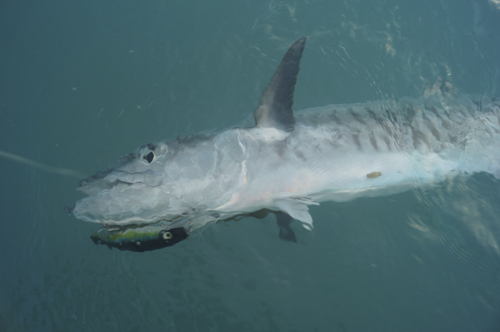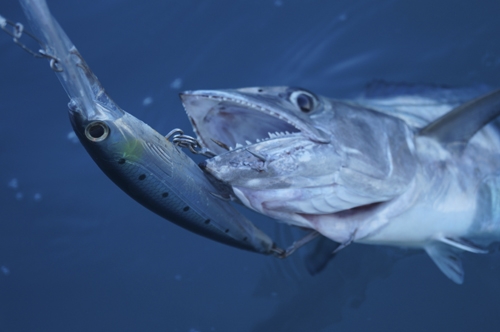Trolling Deep and Fast – By Dave Magner
These days there are so many lures on the market that it’s a relatively simple task to find one which will perfectly suit the way you want to fish. Need a lure to run at a specific depth? No problem! You can walk into your average tackle store, and they will have a range of lures capable of swimming anywhere from right across the surface all the way down to the old 40-foot mark.
You can also find lures which can be trolled as slow or as fast as you need. You can get lures like the good old flatfish, which work best at a very lazy walking pace, up to high-speed bibless minnows which will still be hanging in there at close to 15 knots.
The problems really only start once you try to find a lure that can go both deep and fast. The reason that’s such a hard combination to get your hands on is because you are asking the lure’s bib to do two very different things at the same time. First, the bib has got to try and bite into the water to take the lure down. While it’s doing that, it’s also trying to shed water fast enough to maintain balance. That’s a tough ask, and up until a few years ago, nobody had really been able to nail it.
The breakthrough finally arrived with Rapala’s Magnum Xrap series. These big bluewater minnows were a real revelation when they hit our shores. Finally, trollers had a hard-bodied deep diver which could be towed fast enough to mix with a spread of skirted trolling lures. What’s more, the then largest model in the range got down to 30 feet. They sure brought a lot of big pelagics undone.
Despite the phenomenal success of those magnum Xraps, it took a while for local lure manufacturers to follow in their footsteps, which I guess just goes to prove how hard a feat it was to achieve. In fact, for a good while now, the only locally produced lure I’m familiar with which has a similar mix of depth and high-speed capabilities has been Halco’s Laser Pro 160. These mid-sized minnows come in an XXD bib, with sees them dig down to about six metres and has them still holding in there at ten knots.
While the 160 Laser Pros are a great light to medium tackle lure, anglers looking for something they can drag around on heavy tackle will be pleased to see that Halco has just released an upgraded version of their 190mm Laser Pros. These lures now feature a specially redesigned XXD bib which gives them similar depth and speed capabilities to their smaller brothers, only in a beefed-up package which is much more suited to heavier line classes and serious drag settings.
 Why Deep and Fast?
Why Deep and Fast?
Having just pointed out how hard it is to find lures which can troll deep and fast, I guess you’re probably wondering why anyone would invest all that time and effort into making them in the first place? Well, the answer is simple, mackerel!
You see, Spanish macs (as well as several other pelagic species) love fast moving lures and trolling at somewhere around eight to ten knots really gets them fired up. Speed is only half the story however, and it’s not just how fast the lures swim that’s the real secret. For the best results, your lures also need to get down into the depths where the fish are often sitting. There’s simply no point towing lures around at high speeds if they are passing way over the fish’s heads. In our experience, once the sun comes up, strikes become a lot more frequent when those lures can get down somewhere in between the 20 and 30-foot zone.
Bib Basics
When it comes to hard-bodied lures, it seems that bib design is still not that well understood by a lot of anglers. That all-important piece of plastic or metal which pokes out the front of the lure is what transforms it from a lifeless object into something the fish want to eat. Its angle, shape and size also dictate how deep the lure will dive and how fast it will swim. So, before you go looking for suitable lures, it’s a good idea to have some general bib knowledge.
Generally speaking, deep diving lures will have bibs which point straight out in front of the lure. The closer to horizontal the bib is, the deeper the lure is likely to dive. Conversely, lures with bibs which point down at right angles away from the body are likely to be shallow runners. So, in this case, we’re looking for lures with a relatively horizontal bib.
The next thing to do is look at the profile of the bib from above. Most high-speed divers have an elongated bib, which is longer than it is wide. A long, oval-shaped bib tends to produce a tight action, which in turn, helps the lure to remain more stable at speed. It’s not a hard and fast rule of course, but it’s something to look for, and if you have a look at the photos I’ve included hereabouts, you’ll get an idea of what I mean.
The location of the towing eyelet is another factor in how deep a lure is likely to run. Again, the general rule of thumb is that the deepest divers have the tow point located on the bib itself, rather than the body of the lure. This not only helps them to dive deeper, but it also decreases the amount of drag created when they are being pulled through the water.
It’s worth keeping in mind that having the tow point on the bib can create a potential weak spot in some lures and should the bib break, then the fish goes with it. For heavy tackle fishing, it’s usually safest to stick with one-piece lures (like Xraps) which feature a through wire construction and have the bib moulded as an integral part of the body.
The other alternative is to use something like the new 190 Laser Pros which have the tow point attached directly to the body of the lure. That way you aren’t relying on the strength of the bib to body connection.
Give it a Go
While trolling is not normally considered to be an exciting way to fish, using high-speed deep diving minnows sure spices things up. When a big mack hits a lure doing ten knots, the ratchet screams in pain and the line peels off the spool so quick the drag washers go into meltdown. This in turn usually creates absolute pandemonium for all onboard. The adrenaline levels tend to go through the roof during those first few seconds of a hookup, and everyone starts trying to guess what you’ve hooked and how big it is.
The other thing that keeps me investing in new lures is that high speed deep trolling is such a productive way to fish. By putting in a bit of time and effort and refining our techniques, we’ve been able to hook fish on most trips, and often we come home with an esky full of mackerel.
While the lures we use are not always the cheapest to buy, you only need to invest in a couple to get started. Then it’s just a matter of running them out the back and dragging them around as quick as they’ll go. If you do that in proven mackerel spots, it shouldn’t take you long to start putting a few fish on board.





